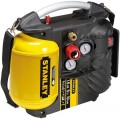The maximum pressure created by the compressor during operation. This parameter, as well as the performance described above, is very important for selecting a compressor for a specific pneumatic tool: it is necessary that the nominal pressure be not lower than the working pressure of the tool. At the same time, high pressure is not a problem — it can be reduced by the appropriate regulator on the gearbox.
Most modern compressors have a
pressure rating of 8 bar, which is sufficient for most air tools. Units for 6 bar belong to the entry level, their main purpose is painting work, where high pressure is not required. There are also options for 10 bar and even more — they, usually, belong to specialized models and cost accordingly. Therefore, it is worth looking specifically for a high-pressure unit only if this parameter is critical for the planned work (for example, if you need a compressor for tyre fitting).
When selecting according to the nominal pressure, it must be taken into account that the maximum allowable pressure in the receiver is usually indicated as the nominal pressure. The pressure actually given out by the compressor to the outlet is often somewhat less, this is due to some design features. For the most popular nominal pressure options — 8 and 10 bar — the real figures are usually 2 bar less, i.e. 6 and 8 bar respectively.
The receiver is a tank (cylinder) into which compressed air is pumped during operation of the compressor; it is from this cylinder (and not directly from the working mechanism) that it is fed to the connected instrument. The main meaning of such a scheme is that the receiver compensates for pressure unevenness that occurs during the operation of the main mechanism; it does not guarantee absolute constancy, however, all changes occur very smoothly. In addition, energy savings are ensured in this way: part of the time the compressor runs on the stored air from the receiver, and the engine turns on only when the pressure in the tank is significantly reduced to replenish supplies. Therefore, this piece of equipment is practically mandatory, models
without a receiver are extremely rare today.
In general, the larger the volume of the receiver, the less often it will have to be pumped up after the initial filling with compressed air. It is also believed that a volumetric receiver can partly compensate for the lack of compressor performance; however, this moment does not ensure the constant stable operation of the “gluttonous” tool and serves only as a fallback in case of a short-term increase in air consumption. On the other hand, large volumes mean the corresponding dimensions of the tank (and it is already the largest part in most compressors), and the cost of the device increases accordingly. Therefore, when choosing, it is worth observi
...ng a certain balance and choosing a receiver depending on the specifics of the work. For various types of activities there are recommendations, they can be found in special sources. Here we note that for relatively uniform work in time with a small air flow, a small receiver is usually enough, and if peak loads can occur frequently, it is better to choose a larger cylinder.
Some compressors may provide the expansion of the receiver with additional tanks.
